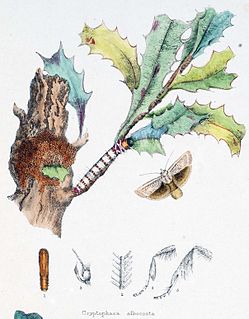| Catoryctis | |
|---|---|
| Scientific classification | |
| Kingdom: | Animalia |
| Phylum: | Arthropoda |
| Class: | Insecta |
| Order: | Lepidoptera |
| Family: | Xyloryctidae |
| Genus: | Catoryctis Meyrick, 1890 |
Catoryctis is a genus of moths of the family Xyloryctidae. [1]
| Catoryctis | |
|---|---|
| Scientific classification | |
| Kingdom: | Animalia |
| Phylum: | Arthropoda |
| Class: | Insecta |
| Order: | Lepidoptera |
| Family: | Xyloryctidae |
| Genus: | Catoryctis Meyrick, 1890 |
Catoryctis is a genus of moths of the family Xyloryctidae. [1]

Ardozyga is a genus of moths in the family Gelechiidae.

Macrobathra is a genus of moths in the family Cosmopterigidae. Most species are endemic to Australia.

Lichenaula is a genus of Australian moth of the family Xyloryctidae.

Tirathaba is a genus of moths of the family Pyralidae described by Francis Walker in 1864.

Xyloryctidae is a family of moths contained within the superfamily Gelechioidea described by Edward Meyrick in 1890. Most genera are found in the Indo-Australian region. While many of these moths are tiny, some members of the family grow to a wingspan of up to 66 mm, making them giants among the micromoths.

Eulechria is a genus of moths of the family Oecophoridae.

Agriophara is a genus of moths in the subfamily Stenomatinae. The genus was erected by Rudolph Rosenstock in 1885.

Cryptophasa is a genus of moths of the family Xyloryctidae.

Plectophila is a genus of moths of the family Xyloryctidae.
Catoryctis eugramma is a moth in the family Xyloryctidae. It was described by Edward Meyrick in 1890. It is found in Australia, where it has been recorded from New South Wales and Queensland.
Catoryctis mediolinea is a moth in the family Xyloryctidae. It was described by Thomas Pennington Lucas in 1894. It is found in Australia, where it has been recorded from New South Wales and Queensland.
Catoryctis nonolinea is a moth in the family Xyloryctidae. It was described by Thomas Pennington Lucas in 1894. It is found in Australia, where it has been recorded from New South Wales and Queensland.